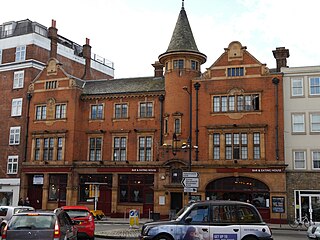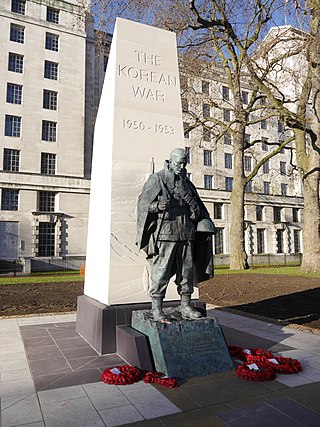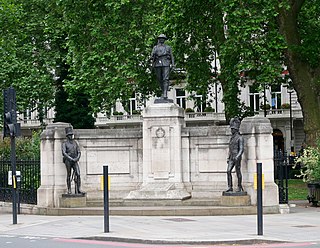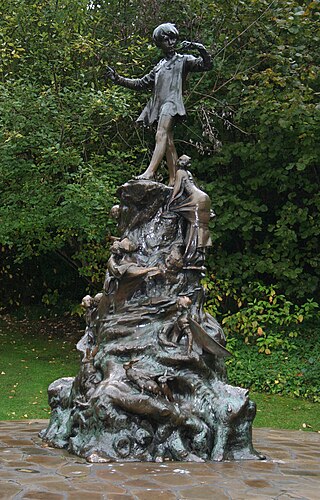
St John's Gardens is an open space in Liverpool, England, to the west of St George's Hall. The gardens are part of the William Brown Street conservation area, and comprise one of the two open spaces within Liverpool's World Heritage Site. It has been a Green Flag site since 2003. The gardens contain ornamental flower beds, and memorials to notable people of the city.

La Délivrance is a 1914 bronze statue by the French sculptor Émile Oscar Guillaume (1867–1942). The statue was created as a celebration of the First Battle of the Marne, when the German army was stopped before capturing Paris in August 1914.

The Parish Church of St Jude-on-the-Hill, is the parish church of Hampstead Garden Suburb in north London. The suburb was founded in 1907 by Henrietta Barnett to be a model community where all classes of people could live together in attractive surroundings and social harmony.

All Saints' Church is the ancient parish church of Fulham, in the County of Middlesex, pre-dating the Reformation. It is now an Anglican church in Fulham, London, sited close to the River Thames, beside the northern approach to Putney Bridge. The church tower and interior nave and chancel are Grade II* listed.

Margravine Cemetery, also known as Hammersmith Cemetery, is in the London Borough of Hammersmith and Fulham. The closest London Underground station is Barons Court.

The Royal Fusiliers War Memorial is a memorial in London, dedicated to the members of the Royal Fusiliers killed in the World Wars, Russian Civil War and subsequent conflicts, along with members of a number of London Regiment battalions killed in the First World War. It consists of a bronze statue on a 16.5 feet (5.0 m) pedestal made of Portland stone.

The King's Head is a Grade II listed public house at 4 Fulham High Street, Fulham, London.

Physical Energy is a bronze equestrian statue by English artist George Frederic Watts. Watts was principally a painter, but also worked on sculptures from the 1870s. Physical Energy was first cast in 1902, two years before his death, and was intended to be Watts's memorial to "unknown worth". Watts said it was a symbol of "that restless physical impulse to seek the still unachieved in the domain of material things". The original plaster maquette is at the Watts Gallery, and there are four full-size bronze casts: one in London, one in Cape Town, one in Harare and one soon to be sited at Watts Gallery - Artists' Village in Compton, Surrey. Other smaller bronze casts were also made after Watts's death.

A memorial to the British soldiers in the Korean War was unveiled in Victoria Embankment Gardens, between the River Thames and the Ministry of Defence headquarters in London, England, on 3 December 2014. The memorial, a bronze statue of a British soldier by the sculptor Philip Jackson, with a Portland stone obelisk on a Welsh slate base, was a gift from the Government of South Korea and was unveiled in a ceremony led by Prince Richard, Duke of Gloucester.

The Baltic Exchange Memorial Glass comprises several stained glass windows designed by English artist John Dudley Forsyth which were installed over a staircase at the Baltic Exchange in London in 1922, as a memorial to the members of the exchange who were killed while serving during the First World War. The memorial glass was damaged in an IRA bombing in 1992. With funding from Swiss Re, the memorial glass was restored by glass conservators Goddard & Gibbs, and has been displayed at the National Maritime Museum in Greenwich since 2005.

St Saviour's War Memorial is a war memorial on Borough High Street, in the former parish of Southwark St Saviour, to south of the River Thames in London. It became a Grade II listed building in 1998 and was upgraded to Grade II* in 2018.

The New Barnet War Memorial stands on a triangular plot at the junction of Station Road and Lyonsdown Road, New Barnet. It is grade II listed with Historic England.

The principal war memorial in Enfield Town is the cenotaph that stands in Chase Green Gardens and is a grade II listed monument with Historic England. It commemorates men lost in both the World Wars as does a plaque in the town's main post office. In addition, in 2003 a memorial to those lost in the Arctic campaign of the Second World War was unveiled.

The Rifle Brigade War Memorial in London commemorates the service of the Rifle Brigade in the First and Second World Wars. It stands at the junction of Grosvenor Gardens and Hobart Place near Victoria Station in the City of Westminster, on land donated by the 2nd Duke of Westminster.

Atalanta is a statue by the British sculptor Francis Derwent Wood. It shows a naked woman standing in a contrapposto position, glancing to her left, with her left hand by her side and right hand raised to her shoulder. The subject is Atalanta, a virgin huntress from Greek mythology; she may be preparing for the foot race she used as an obstacle to prevent suitors securing a marriage.

The Eagle Squadrons Memorial is a Second World War memorial in Grosvenor Square, London. It commemorates the service of the three Royal Air Force Eagle Squadrons from 1940 to 1942, during the Battle of Britain, and in particular their 244 Americans and 16 British fighter pilots, of whom 71 were killed. The bronze sculpture of an eagle which tops the memorial is by Elisabeth Frink.

The statue of Peter Pan is a 1912 bronze sculpture of J. M. Barrie's character Peter Pan. It was commissioned by Barrie and made by Sir George Frampton. The original statue is displayed in Kensington Gardens in London, to the west of The Long Water, close to Barrie's former home on Bayswater Road. Barrie's stories were inspired in part by the gardens: the statue is at the place where Peter Pan lands in Barrie's 1902 book The Little White Bird after flying out of his nursery. Six other casts made by Frampton have been erected in other places around the world.

The Royal Artillery Boer War Memorial is located on the south side of The Mall in Central London, close to the junction with Horse Guards Road at the northeast corner of St James's Park. Unveiled in 1910, it marks the deaths of the 1,083 soldiers of the Royal Artillery who died in the Second Boer War from 1899 to 1902 It has been a listed building since 1970.




















